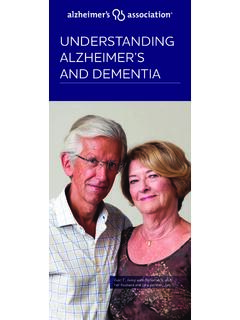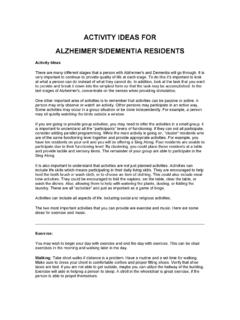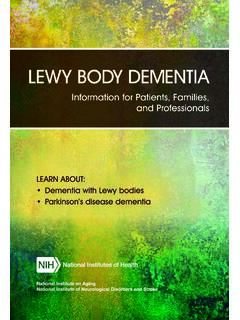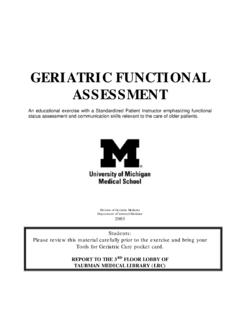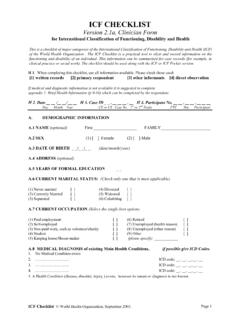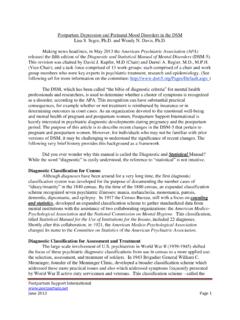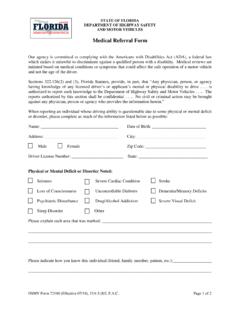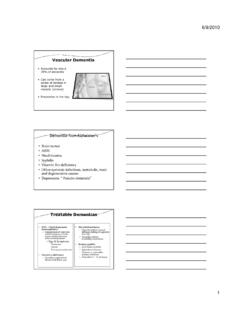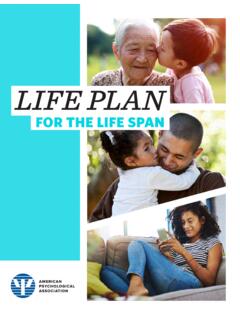Transcription of NTG-EDSD - aadmd.org
1 NTG-EDSD The NTG-Early Detection Screen for Dementia, adapted from the DSQIID*, can be used for the early detection screening of those adults with an intellectual disability who are suspected of or may be showing early signs of mild cognitive impairment or dementia. The NTG-EDSD is not an assessment or diagnostic instrument, but an administrative screen that can be used by staff and family caregivers to note functional decline and health problems and record information useful for further assessment, as well as to serve as part of the mandatory cognitive assessment review that is part of the Affordable Care Act's annual wellness visit for Medicare recipients. This instrument complies with Action of the US National Plan to Address Alzheimer's Disease. It is recommended that this instrument be used on an annual or as indicated basis with adults with Down syndrome beginning with age 40, and with other at-risk persons with intellectual or developmental disabilities when suspected of experiencing cognitive change.
2 The form can be completed by anyone who is familiar with the adult (that is, has known him or her for over six months), such as a family member, agency support worker, or a behavioral or health specialist using information derived by observation or from the adult's personal record. The estimated time necessary to complete this form is between 15 and 60 minutes. Some information can be drawn from the individual's medical/health record. Consult the NTG-EDSD Manual for additional instructions ( screening). (1) (2). File #: _____ Date: _____. (3) (4). Name of person: First_____ Last: _____. (5) (6). Date of birth: _____ Age: _____. (7). Sex: Female Instructions: Male For each question block, check the item that best applies to the individual or situation. (8). Best description of level of intellectual disability No discernible intellectual disability Borderline (IQ 70-75). Mild ID (IQ 55-69). Moderate ID (IQ 40-54).
3 Severe ID (IQ 25-39). Profound ID (IQ 24 and below). Unknown Current living arrangement of person: Lives alone (9). Diagnosed condition (check all that apply) Lives with spouse or friends Lives with parents or other family members Autism Lives with paid caregiver Cerebral palsy Lives in community group home, apartment, Down syndrome supervised housing, etc. Fragile X syndrome Lives in senior housing Intellectual disability Lives in congregate residential setting Prader-Willi syndrome Lives in long term care facility Other: Lives in other: _____. NTG-EDSD - page 2. (10) (15). General characterization of current physical health: Seizures Excellent Recent onset seizures Very good Long term occurrence of seizures Good Seizures in childhood, not occurring in Fair adulthood Poor No history of seizures (11). Compared to one year ago, current physical health is: If MCI or dementia is documented complete 16, 17, &18.
4 Much better Somewhat better (16). Diagnostic History About the same Somewhat worse Mild cognitive impairment [MCI] or dementia previously diagnosed (Dx)?: Much worse [ ] No (12). Compared to one year ago, current mental health is: [ ] Yes, MCI. Much better Date of Dx: Somewhat better [ ] Yes, dementia About the same Date of Dx: Somewhat worse Much worse Type of dementia: (13). Conditions present (check all that apply) Diagnosed by: Geriatrician Vision impairment Neurologist Blind (very limited or no vision) Physician Psychiatrist Vision corrected by glasses Psychologist Hearing impairment Other: Deaf (very limited or no hearing). Hearing corrected by hearing aids (17). Mobility impairment Reported date of onset of MCI/dementia Not mobile uses wheelchair [When suspicion of dementia first arose]. Note approximate year and month: Not mobile is moved about in wheelchair (14). Significant recent [in past year] life event (check all that apply).
5 (18). Comments / explanations about dementia Death of someone close suspicions: Changes in living arrangement, work, or day program Changes in staff close to the person New roommate/housemates Illness or impairment due to accident Adverse reaction to medication or over-medication Interpersonal conflicts Victimization / abuse Other: NTG-EDSD - page 3. [Check column option as appropriate]. Always Always New Does been the but symptom not case worse in past apply year (19). Activities of Daily Living Needs help with washing and/or bathing Needs help with dressing Dresses inappropriately ( , back to front, incomplete, inadequately for weather). Undresses inappropriately ( , in public). Needs help eating (cutting food, mouthful amounts, choking). Needs help using the bathroom (finding, toileting). Incontinent (including occasional accidents). (20). Language & Communication Does not initiate conversation Does not find words Does not follow simple instructions Appears to get lost in middle of conversation Does not read Does not write (including printing own name).
6 (21). Sleep-Wake Change Patterns Excessive sleep (sleeping more). Inadequate sleep (sleeping less). Wakes frequently at night Confused at night Sleeps during the day more than usual Wanders at night Wakes earlier than usual Sleeps later than usual (22). Ambulation Not confident walking over small cracks, lines on the ground, patterned flooring, or uneven surfaces Unsteady walk, loses balance Falls Requires aids to walk NTG-EDSD - page 4. Always Always New Does been the but symptom not case worse in past apply year (23). Memory Does not recognize familiar persons (staff/relatives/friends). Does not remember names of familiar people Does not remember recent events (in past week or less). Does not find way in familiar surroundings Loses track of time (time of day, day of the week, seasons). Loses or misplaces objects Puts familiar things in wrong places Problems with printing or signing own name Problems with learning new tasks or names of new people (24).
7 Behavior and Affect Wanders Withdraws from social activities Withdraws from people Loss of interest in hobbies and activities Seems to go into own world Obsessive or repetitive behavior Hides or hoards objects Does not know what to do with familiar objects Increased impulsivity (touching others, arguing, taking things). Appears uncertain, lacks confidence Appears anxious, agitated, or nervous Appears depressed Shows verbal aggression Shows physical aggression Temper tantrums, uncontrollable crying, shouting Shows lethargy or listlessness Talks to self (25). Adult's Self-reported Problems Changes in ability to do things Hearing things Seeing things Changes in thinking'. Changes in interests Changes in memory (26). Notable Significant Changes Observed by Others In gait ( , stumbling, falling, unsteadiness). In personality ( , subdued when was outgoing). In friendliness ( , now socially unresponsive).
8 In attentiveness ( , misses cues, distracted). In weight ( , weight loss or weight gain). In abnormal voluntary movements (head, neck, limbs, trunk). NTG-EDSD - page 5. [Check column option as appropriate]. (27). Chronic Health Conditions* Recent Condition Lifelong Condition condition diagnosed in condition not present (past year) last 5 years Bone, Joint and Muscle 1 Arthritis 2 Osteoporosis Heart and Circulation 3 Heart condition 4 High cholesterol 5 High blood pressure 6 Low blood pressure 7 Stroke Hormonal 8 Diabetes (type 1 or 2). 9 Thyroid disorder Lungs/breathing 10 Asthma 11 Chronic bronchitis, emphysema 12 Sleep disorder Mental health 13 Alcohol or substance abuse 14 Anxiety disorder 15 Attention deficit disorder 16 Bipolar disorder 17 Dementia/Alzheimer's disease 18 Depression 19 Eating disorder (anorexia, bulimia). 20 Obsessive-compulsive disorder 21 Schizophrenia 22 Other: Pain / Discomfort 23 Back pain 24 Constipation 25 Foot pain 26 Gastrointestinal pain or discomfort 27 Headaches 28 Hip/knee pain 29 Neck/shoulder pain Sensory 30 Dizziness / vertigo 31 Impaired hearing 32 Impaired vision Other 33 Cancer type: 34 Chronic fatigue 35 Epilepsy / seizure disorder 36 Heartburn / acid reflux 37 Urinary incontinence 38 Sleep apnea 39 Tics/movement disorder/spasticity 40 Dental pain *Items drawn from the Longitudinal Health and Intellectual Disability Survey (University of Illinois at Chicago).
9 NTG-EDSD - page 6. (28). Current Medications Yes No Indicate type Treatment of chronic conditions Treatment of mental health disorders or behavior problems Treatment of pain For reviews, attach list of current medications, dosage, and when prescribed List is attached for reviews (29). Comments related to other notable changes or concerns: (30). Next Steps / Recommendations Refer to treating physician for assessment Review internally by clinical personnel Include in annual review / annual wellness visit Repeat in _____ months Form completion information (31) (32). Date completed Organization / Agency Name of person completing form Relationship to individual (staff, relative, assessor, etc.). Date(s) form previously completed Acknowledgement: Derived from the DSQIID (*Dementia Screening Questionnaire for Individuals with Intellectual Disabilities; Deb, S., 2007) as adapted into the Southeast PA Dementia Screening Tool (DST) with the assistance of Carl V.
10 Tyler, Jr., MD and the LHIDS (Longitudinal Health and Intellectual Disability Survey;. Rimmer & Hsieh, 2010) and as further adapted by the National Task Group on Intellectual Disabilities and Dementia Practices as the NTG Early Detection Screen for Dementia for use in the USA. AADMD/NTG 1 National Task Group on Intellectual Disabilities and Dementia Practices

